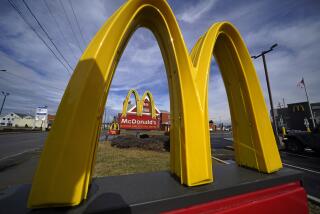Japan Fighting Lethal Strain of E. Coli Bacteria
- Share via
TOKYO — Public health authorities snapped into action Monday to tackle a virulent strain of bacteria that has sickened at least 6,333 people in southern Japan, most of them children believed to have contracted acute food poisoning from their school lunches.
The culprit in Japan’s worst food poisoning outbreak in a decade is the same strain of E. coli bacteria that tainted American hamburgers in the West in 1993, killing four people and making about 500 others ill.
A 56-year-old Kyoto man died Sunday, bringing the death toll to at least four since the epidemic began in May. Hundreds have been hospitalized; 27 people were listed as seriously ill Monday evening, including two schoolgirls, ages 7 and 12, who had lost consciousness and were in critical condition, Asahi television reported.
The scale of the outbreak, which has now spread to 32 prefectures, has caused widespread alarm in Japan, where cleanliness and hygiene easily outrank godliness in the pantheon of public virtues.
Health officials on Monday ordered schools in hard-hit areas to test their water supplies for the bacteria named 0157. Because the highly infectious microbe has been reported to spread through inadequately chlorinated water, public swimming pools were also shut Monday in the city of Sakai in Osaka prefecture, where about 5,000 children have fallen ill.
Anxious mothers kept their children indoors amid sweltering summer heat, and health workers went door to door interviewing victims and giving sanitation tips for preventing infection from spreading to other family members.
Health officials ordered school lunch providers and other food preparers to preserve all leftovers for two weeks to help epidemiologists track the elusive source of the epidemic.
A bad batch of eel is the suspect in the Sakai lunch poisonings. But other regional outbreaks have been blamed on contaminated fish and pork salads and tainted liver. The Japanese relish raw beef liver and consider it a delicacy.
The Kyoto man reportedly ate at a cafeteria at work; two of his colleagues are also sick. The connection to the other victims, if any, is unknown.
The 0157 strain is maddeningly difficult to trace because, unlike other bacteria, which produce symptoms in hours or days, its incubation period is up to eight days, said Akira Miki of the Health and Welfare Ministry’s food sanitation division.
“People can’t remember what they ate a week ago,” he said. Even if they do, by the time they succumb, the remnants of their meal have usually been thrown away.
Moreover, whereas a person must ingest about 1 million salmonella bacteria to fall ill, swallowing a few hundred 0157 bacteria is enough to make a person sick, Miki said.
The World Health Organization has reports of 0157 outbreaks in the United States, Canada, Europe and Africa, said Dr. Kazuaki Miyagishima of WHO’s Food Safety Unit.
(BEGIN TEXT OF INFOBOX / INFOGRAPHIC)
The Deadly Trail
E. coli O157 bacteria is spread through a variety of foods as well as human contact. The infection is particularly dangerous to children, who are at risk of a disastrous complication called hemolytic uremic syndrome, which can cause kidney failure. In the United States, a strain of E. coli caused about 500 people to fall ill in 1993 after eating undercooked hamburgers in the West.
PRECAUTIONS
* Avoid consumption of raw meat
* Careful food preparation
* Greater attention to hygiene
SYMPTOMS
* Severe vomiting
* Diarrhea
* Fever
* Low blood pressure
* Dehydration
E. COLI CASES IN JAPAN
Latest outbreak: At least 6,333
Average annual number of cases: 100
More to Read
Sign up for Essential California
The most important California stories and recommendations in your inbox every morning.
You may occasionally receive promotional content from the Los Angeles Times.









